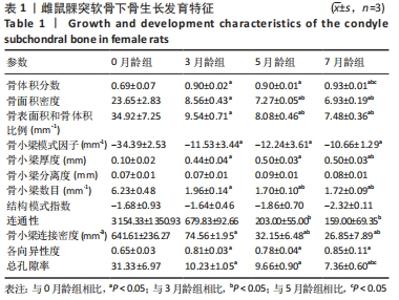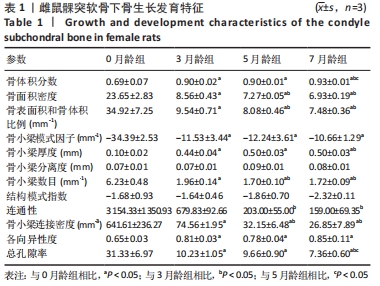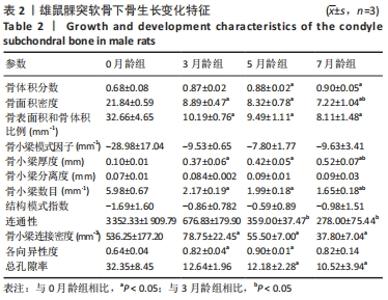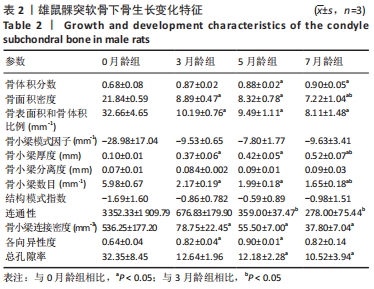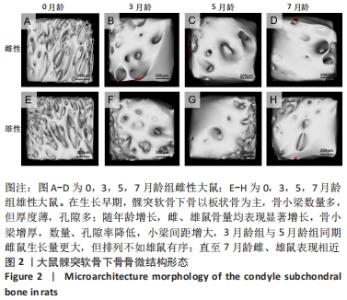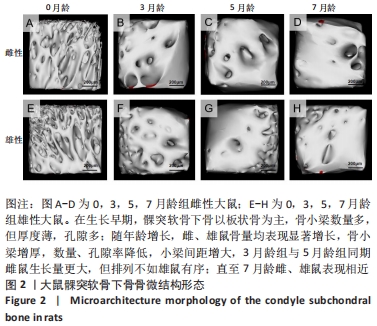[1] CHAI Y, JR R. Recent advances in craniofacial morphogenesis. Dev Dyn. 2010; 235(9):2353-2375.
[2] RABIE AB, XIONG H, HAGG U. Forward mandibular positioning enhances condylar adaptation in adult rats.Eur J Orthod. 2004;26(4):353-358.
[3] KAYIPMAZ S, AKCAY S, SEZGIN ÖS, et al. Trabecular structural changes in the mandibular condyle caused by degenerative osteoarthritis: a comparative study by cone-beam computed tomography imaging. Oral Radiol. 2019;35(1): 51-58.
[4] KOVACS B, VAJDA E, NAGY EE. Regulatory Effects and Interactions of the Wnt and OPG-RANKL-RANK Signaling at the Bone-Cartilage Interface in Osteoarthritis. Int J Mol Sci. 2019;20(18):4653.
[5] ROSS DS, YRT TH, KING S, et al. Distinct Effects of a High Fat Diet on Bone in Skeletally Mature and Developing Male C57BL/6J Mice. Nutrients. 2021; 13(5):1666.
[6] SLEEPER EL. Open reduction of condylar fracture. Oral Surg Oral Med Oral Pathol. 1952;5(1):4-9.
[7] SUZUKI S. Histomorphometric study on growing condyle of rat. Bull Tokyo Med Dent Univ. 1986;33(1):23-34.
[8] ZHANG HY, LIU Q, YANG HX, et al. Early growth response 1 reduction in peripheral blood involving condylar subchondral bone loss. Oral Dis. 2019; 25(7):1759-1768.
[9] WANG Z, SA G, WEI Z, et al. Obvious morphologic changes in the mandible and condylar cartilage after triple botulinum toxin injections into the bilateral masseter. Am J Orthod Dentofacial Orthop. 2020;158(4):e43-e52.
[10] THIRUNA AJ, FERRO A, SARDESAI A, et al. Temporomandibular joint anatomy: Ultrasonographic appearances and sexual dimorphism. Clin Anat. 2021;34(7):1043-1049
[11] 周星宇. 慢性氟中毒对大鼠正畸牙移动压力侧牙周组织改建及相关骨效应变化[D]. 贵阳: 贵州医科大学,2020.
[12] JIAO K, DAI J, WANG MQ, et al. Age- and sex-related changes of mandibular condylar cartilage and subchondral bone: a histomorphometric and micro-CT study in rats. Arch Oral Biol. 2010;55(2):155-163.
[13] QUINN R. Comparing rat’s to human’s age: how old is my rat in people years? Nutrition. 2005;21(6):775-777.
[14] 张悦,李运峰.骨质疏松症动物模型研究进展[J].中国骨质疏松杂志, 2020,26(1):152-156.
[15] 郑振辉. 实用医学实验动物学[M]. 北京: 北京大学医学出版社,2008:222-224.
[16] EMSHOFF R, BERTRAM A, HUPP L, et al. A logistic analysis prediction model of TMJ condylar erosion in patients with TMJ arthralgia. BMC Oral Health. 2021;21(1):374.
[17] CHEN PJ, DUTRA EH, MEHTA S, et al. Age-related changes in the cartilage of the temporomandibular joint. Gero Sci. 2020;42(3):995-1004.
[18] HUANG L, ZHANG L, LI H, et al. Growth pattern and physiological characteristics of the temporomandibular joint studied by histological analysis and static mechanical pressure loading testing. Arch Oral Biol. 2020; 111:104639.
[19] ROSS DS, YRT TH, KING S, et al. Distinct Effects of a High Fat Diet on Bone in Skeletally Mature and Developing Male C57BL/6J Mice. Nutrients. 2021; 13(5):1666.
[20] SENGUPTA P. The Laboratory Rat: Relating Its Age With Human’s. Int J Prev Med. 2013;4(6):624-630.
[21] YU YE, HU YJ, ZHOU B, et al. microarchitecture Determines Apparent-Level Mechanics Despite Tissue-Level Anisotropy and Heterogeneity of Individual Plates and Rods in Normal Human Trabecular Bone. J Bone Miner Res. 2021; 36(9):1796-1807.
[22] DING M, OOVERGAARD S. 3-D microarchitectural properties and rod- and plate-like trabecular morphometric properties of femur head cancellous bones in patients with rheumatoid arthritis, osteoarthritis, and osteoporosis. J Orthop Translat. 2021;28:159-168.
[23] ZAIDI M. Skeletal remodeling in health and disease.Nat Med. 2007;13(7):791-801.
[24] BARGER-LUX MJ , RECKKER RR. Bone microarchitecture in osteoporosis: transilial biopsy and histomorphometry. Top Mag Res Imag. 2002;13(5):297.
[25] 魏占英, 章振林. Micro-CT在骨代谢研究中骨微结构指标的解读及应用价值[J]. 中华骨质疏松和骨矿盐疾病杂志,2018,11(2):96-101.
[26] MACHO GA, ABEL RL, SCHUTKOWSKI H . Age changes in bone microstructure: do they occur uniformly? Int J Osteoarch. 2010;15(6):421-430.
[27] 黄林剑,蔡协艺,李辉,等.兔关节盘、髁突及软骨下骨的年龄相关性改变组织学研究[J].口腔颌面外科杂志,2015,25(1):19-23.
[28] JOO W, SINGH H, Ahles CP,et al. Training-induced Increase in Bone Mineral Density between Growing Male and Female Rats. Int J Sports Med. 2015;36(12):992-998.
[29] Zamli Z, Robson Brown K, Sharif M. Subchondral Bone Plate Changes More Rapidly than Trabecular Bone in Osteoarthritis. Int J Mol Sci. 2016;17(9):1496.
[30] 白小帆.中国男性腰椎松质骨生物学参数随年龄变化的研究[D]. 长春: 吉林大学,2013.
[31] CHEN Y, HU Y, YU YE, ZHANG X, et al. Subchondral Trabecular Rod Loss and Plate Thickening in the Development of Osteoarthritis. J Bone Miner Res. 2018;33(2):316-327.
[32] MICHAEL Z, EMELY LB, PETER F, et al. Normal trabecular vertebral bone is formed via rapid transformation of mineralized spicules: A high-resolution 3D ex-vivo murine study. Acta Bio. 2019;86:429-440.
[33] WANG L, MCMAHAN CA, BANU J, et al. Rodent model for investigating the effects of estrogen on bone and muscle relationship during growth. Calcif Tissue Int. 2003;72(2):151-155.
[34] LEI J, LIU MQ, YAP A, et al. Condylar subchondral formation of cortical bone in adolescents and young adults. Br J Oral Maxillofac Surg. 2013;51(1):63-68.
[35] YE T, SUN D, MU T, et al. Differential effects of high-physiological oestrogen on the degeneration of mandibular condylar cartilage and subchondral bone. Bone. 2018;111:9-22.
[36] GABEL L, MACDONALD HM, MCKAY HA. Sex Differences and Growth-Related Adaptations in Bone Microarchitecture, Geometry, Density, and Strength From Childhood to Early Adulthood: A Mixed Longitudinal HR-pQCT Study. J Bone Miner Res. 2017;32(2):250-263.
[37] STURZNICKEL J, SCHMIDT FN, SCHAFER HS, et al. Bone microarchitecture of the distal fibula assessed by HR-pQCT. Bone. 2021;151:116057.
[38] ANDREOLLO NA, SANTOS E, MR A, et al. Rat’s age versus human’s age: what is the relationship? Arq Bras Cir Dig. 2012;25:49-51.
|
